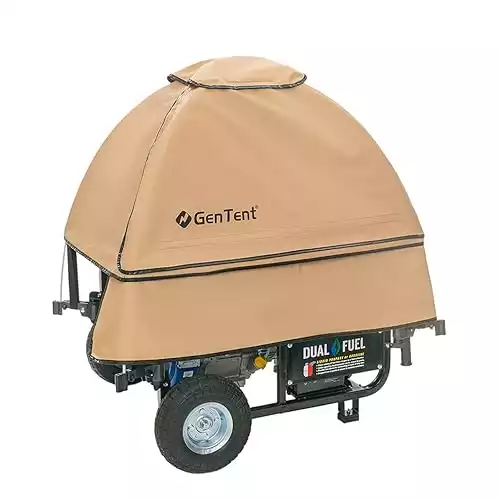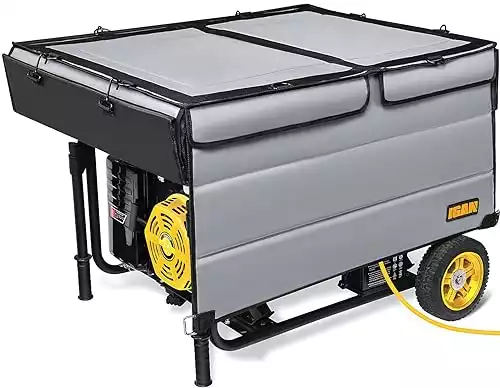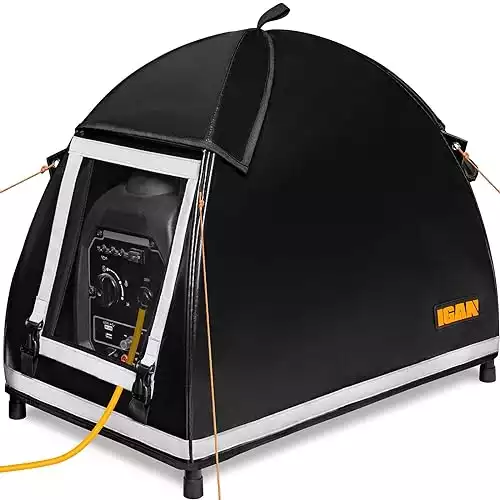Natural disasters often bring with them high winds, flooding, and rain. It pays to know the safety implications of using your generator in wet weather if you rely on a portable generator for backup power.
Here, we will go over the following:
- Should I run a generator in the rain?
- What are the dangers?
- How to run a generator safely
- Can I run a generator in the rain if it is covered?
- How to build a generator cover
Can I Run a Generator In The Rain?
Never run a generator in the rain or wet unless you have a high-quality generator tent or shelter. You are in danger of electrocution or severe damage to your generator if you operate a portable generator during wet weather.
The Dangers Of Running A Generator In The Rain
Wet weather makes it challenging to run a generator safely unless you have it in a well-ventilated enclosure. Some of the specific concerns associated with running a generator in unfavorable weather conditions include:
#1 Electrocution
This can occur after and during a storm, and touching a wet generator while running could be fatal.
You can reduce the risk of electrocution by ensuring your generator is properly grounded. The best way of doing this is by installing a portable ground fault circuit interrupter (GFCI).
It’s not only the generator that could deliver a nasty shock, either. If you’re standing in a puddle while operating the generator, even the best GFCI will do little to soften the blow.
To protect the generator, only operate it on dry ground, preferably with the generator safely stored under some canopy.
#2 Generator Malfunction
If water enters any part of the generator, it could ruin certain components and cause irreparable damage, leaving you on the market for a replacement dual fuel generator and facing outlay costs of $500 or more.
#3 Fire Hazards
Even if you’ve been smart enough to cover your generator, you could still be in danger. Without sufficient ventilation, generators won’t get enough airflow to work effectively and may even catch fire.
Similarly, storing fuel too close to the generator or overloading are potential fire hazards. A fire extinguisher nearby can help reduce the damage, but it won’t do much to eliminate risk.
Although you can leave a portable generator in the rain if you’re not using it, exposure to the elements will mean more maintenance and more potential problems in the long run. This is why we recommend buying or building a cover for your backup generator.
3 Tips On How To Run A Generator Safely
Generators use fuel to produce a powerful voltage, making them potentially dangerous machines, especially when there’s lots of water around. To prevent damage to your generator and yourself, keep the following generator safety tips in mind:
#1 Don’t Run Your Generator In The Rain Or Near Water
Although pure water doesn’t conduct electricity because it’s free of electrons, naturally occurring water, like rain or the water in your pool or sprinkler system, contains sediments and minerals that ionize the water molecules, enabling them to conduct electricity.
If you even touch one of the electrical components of your generator with wet hands, you could get a nasty electrical shock. Imagine how much worse it is if your generator’s sitting in a puddle of water while the rain hammers down on both you and it.
#2 Keep Your Generator Outside And Far From Your Home
When storm clouds gather overhead, moving your generator inside is tempting. The trouble is that running a generator inside even the most well-ventilated area is hazardous.
According to the Consumer Products Safety Commission, even the more safety-minded among us unknowingly put ourselves in danger simply by placing our generators too close to or inside the home.
As generators burn fuel, they emit toxins, including monoxide. Inhaling these fumes causes you to lose consciousness and, subsequently, suffocate.
If your generator is situated closer than 10 feet from your house, you’re already exposed to possible carbon monoxide poisoning and should get a CO detector to assess the emission levels.
#3 Never Plug Your Generator Into A Wall Outlet
In your desperation to watch the next installment of your favorite Netflix series, you may be tempted to plug your generator into a wall outlet so that you can power up your laptop.
This method is hazardous and can cause “backfeeding.” This process can permanently damage your electrical system and deliver a potentially fatal jolt of electricity to anyone touching the generator cord or working on the main power lines.
Can I Run My Generator in The Wet If It’s Covered?
Bargain-basement generator covers won’t help much when running a generator safely in the wet.
The cheapest offerings are only designed to protect a generator from the elements while it’s not operating.
If you want a cover that makes it safe to operate your generator in bad weather, you’ll need to fork out a little more than the cost of a basic waterproof generator cover.
The best generator covers, like the one from IGAN, can protect your generator from rain, wind, and snow when it’s dormant and running.
 GenTent Generator Running Cover
GenTent Generator Running Cover
This universal welded waterproof cover is designed for portable generators of any description, assuming they fall into the 3,000 to 10,000-watt category.
According to the manufacturers, this is the “only ENGINEERED product on the market that keeps generators safe to use in rain and severe weather” and has been tab-tested for:
- 70mph winds
- 12″ rain per day
- 18″ snow load
Designed for optimum airflow, this generator tent should keep your machine running at peak performance, even in hurricane conditions.
The waterproof fabric cover is made from -25℃ cold-crack rated fabric, complete with welded, watertight seams. In other words – it’s been built to last.
Such a high-quality piece of equipment doesn’t come cheap, but shelling out a hundred dollars or so on a decent generator cover could extend the life of your machine by years, saving you money in the long run.
 IGAN Generator Cover
IGAN Generator Cover
The IGAN Generator Tent Running Cover is 100% waterproof and designed to protect the most sensitive parts of your machine from the worst weather conditions.
Made from waterproof tarpaulin, this heavy-duty cover comes with a stainless steel frame that fits neatly onto the top of most 3500w-12000w portable generators.
This robust construction prevents the cover from collapsing under heavy rain or snow and provides greater stability in high winds.
 IGAN Small Inverter Generator Tent Cover
IGAN Small Inverter Generator Tent Cover
This smaller, cheaper generator tent cover sports a very different design from our top pick but makes it safe to operate almost any 1000- to 2300-watt inverter regardless of the weather.
Its design ensures the machine remains protected from the elements while giving it sufficient natural airflow to operate effectively and prevent overheating.
With a heavy-duty tarpaulin cover reinforced with a strong metal frame and fiberglass support rods, it’s designed to withstand the most inclement weather.
Although this product receives consistently positive reviews, it should be noted that it is designed only to protect fully enclosed inverter generators rather than framed portable generators.
With a low price tag and a 3-year warranty, this is a great place to start if you don’t want to build your own generator shelter.
How To Build a Generator Shelter
If you’ve got a few DIY skills and some timber lying around, building a generator shelter could work out cheaper than buying one and may even last longer.
It will mean your generator is less portable than it would be with a cover from GenTent or IGAN. Still, it could also mean better protection as you can build it according to your unique requirements and with a knowledge of the prevailing weather direction.
If you’ve got the time and materials to complete it, a good option is to construct a simple shelter like the one in the video below.
This will withstand wind and rain but may not be robust enough to outlast a hurricane.
While converting a plastic storage shed is one option, a plywood shelter is more robust and requires few skills, tools, or materials to complete, as you’ll see from the tutorial below:
Another benefit of this type of shelter is that it doubles up as one of the best ways to silence your generator, meaning it gives you peace and quiet and peace of mind.
When building a generator shelter, make sure you bear the following requirements in mind:
Airflow – without sufficient airflow, a generator will struggle to operate and may even overheat, causing a fire hazard
Ventilation – toxic exhaust fumes are dangerous, so you must ensure your creation has plenty of vents to allow the fumes to dissipate.
Heat – make sure your shelter is large enough to include a heat shield of some description to stop the shelter from melting or catching fire.
Access – if you want to run your generator in the rain, you’ll need access to the fuel tank and other moving parts. Ensure your shelter is big enough to allow easy access without exposing sensitive parts to the elements.
Conclusion
When bad weather causes a power outage, the first thing you want to do is get your backup generator going. However, if it’s still raining cats and dogs outside, this can be extremely dangerous and potentially fatal.
Rather than running the risk of being electrocuted or breaking your generator, either build or buy yourself an effective cover.
Some generator tents have been proven to withstand winds of up to 70mph, but you don’t need to shell out $100 or more to get that level of protection – some sheets of plywood and a little DIY flair could create a robust shelter for less than half the price.



I have a generac 24 Kil watt stationary generator ( of 11.200k) I’d like to make a Protection cover
Any ideas?
Everything I see is for portable ones
Back feeding with a generator can be done if you remove the main breaker so the power doesn’t go to the meter and feed back down the lines where power company crews might be working, its the same principle as a transfer switch.
Agreed, if power outages are a common occurrence, one can also install a disconnect to allow for quick and easy separation from (and re-connection to) grid power. Whenever an outage occurs, all you have to do is turn off breakers or unplug devices you don’t want powered, switch the disconnect to open (no grid), and plug your generator in.